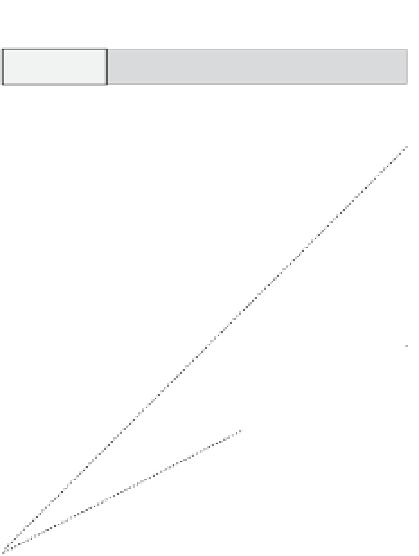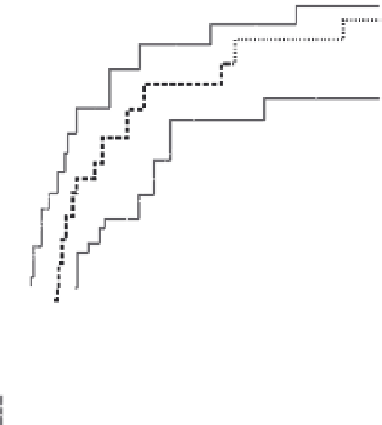Geology Reference
In-Depth Information
within the ECSZ have received little detailed
study. As a consequence, the possibility exists
that seismic moment release is temporally
smoother than it now appears in either the ECSZ
or the Los Angeles basin. Paleoseismologists
will be happy to know that the rupture history
of many more faults needs to be known before
the regional dynamics are fully understood.
Holocene
Late Pleistocene
Slip rate
(mm/yr)
2
Slip
per
event
4
40
3
Slip Rate
Changes
30
Fault slip rates
Average
slip rate
2
20
When a paleoseismic history delineates the slip
for multiple earthquakes on a fault, cumulative
slip versus time plots serve to delineate
the steadiness of deformation. If additional
constraints on slip rates can be incorporated at
longer time scales - such as may be derived
from offset geomorphic markers, larger-scale
structural reconstructions, or even bedrock
cooling and erosion histories - then slip rates
across many time windows can be examined.
Several such compilations that span Late
Pleistocene to Holocene time suggest significant
slip-rate changes have occurred. Across the nor-
mal fault system spanning the easternmost Basin
and Range (extending
∼
80 km westward from
the Wasatch Range), data over the past 15 kyr
(Fig. 6.30) suggest that Holocene slip rates were
up to 10 times faster than Late Pleistocene rates
(Friedrich
et al.
, 2003). This acceleration may
represent a predictable, but surprising, response
to climate change. During the Late Pleistocene,
the hanging wall lying to the west of the Wasatch
Fault was covered by Lake Bonneville (Gilbert,
1890), which was about 300 m deep and covered
some 50 000 km
2
. When the lake abruptly
drained
∼
15 ka, the removal of the water load
should have caused a decrease in normal
stresses on the Wasatch Fault (Hetzel and
Hampel, 2005) and could have initiated the sub-
sequent interval of increased slip.
Perhaps an even more surprising slip-rate
result comes from the long time series on the
San Andreas Fault at Wrightwood. Across 15
earthquakes spanning 1300 years, not only were
rates unsteady, but for one 200-year-long inter-
val when four large earthquakes occurred,
the average slip rate was twice as fast as the
North America-Pacific plate rate (Box 6.3). This
1.5
Hol. L. Pleist.
0.3
mm/yr
1.0
10
mm
/yr
0.5
10
20
30
40
Time (ka)
Fig. 6.30
Slip-rate changes on the Wasatch Fault
system.
Cumulative vertical displacement comprises the summed
offsets from four normal fault systems (Wasatch, West
Valley, Oquirrh, and Stansbury) in the eastern Basin and
Range of Utah. Inset in lower right depicts average
Holocene versus Late Pleistocene slip rates. Modified
after Friedrich
et al.
(2003).
unexpected result suggests that significant
elastic strain can be stored in the crust and then
released over multiple seismic cycles.
Continental collisions and
megathrust earthquakes
Many continent-to-continent collisions are
characterized by fold-and-thrust belts underlain
by a gently dipping sole thrust that extends
from the foreland to far beneath the hinterland,
where it steepens. This sole thrust roughly
coincides with the modern plate interface. In
some ranges, such as the Himalaya, contemporary
GPS, leveling-line measurements (Fig. 5.7), and
ongoing moderate seismicity indicate that
current deformation is focused in the hinterland.
Some studies of deformed Himalayan Holocene
terraces in the foreland (Lavé and Avouac, 2000),



















































